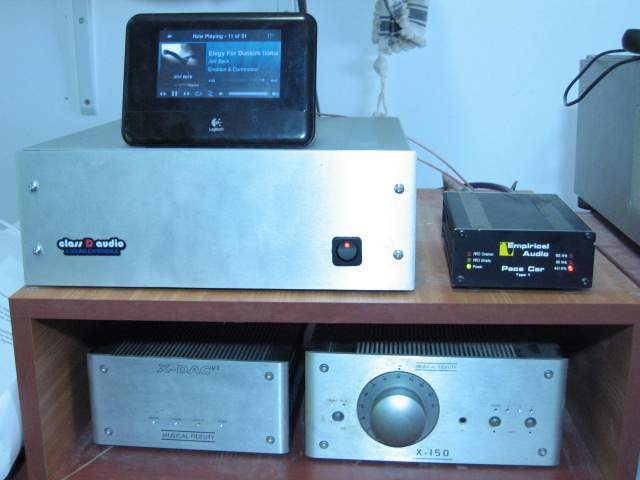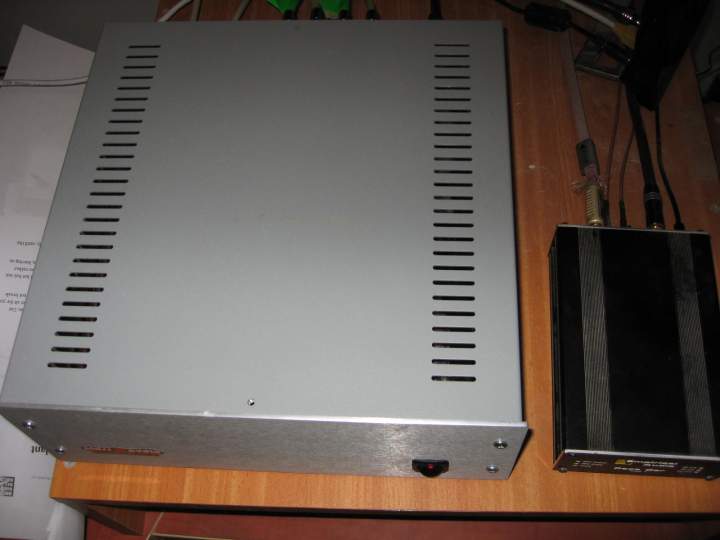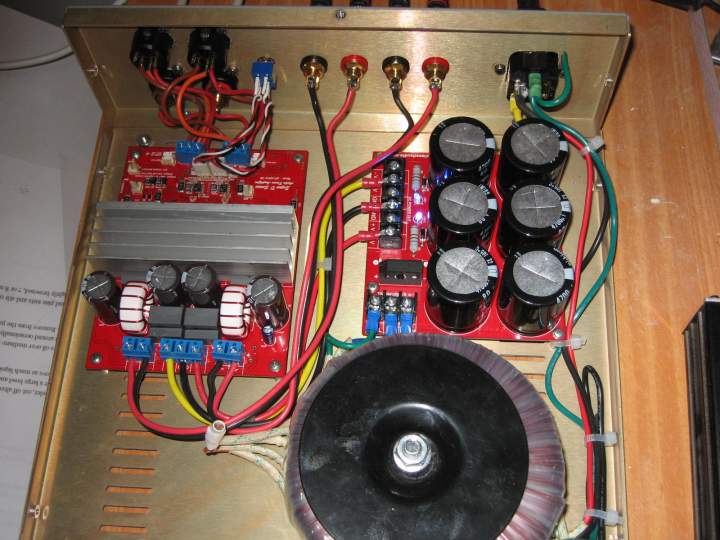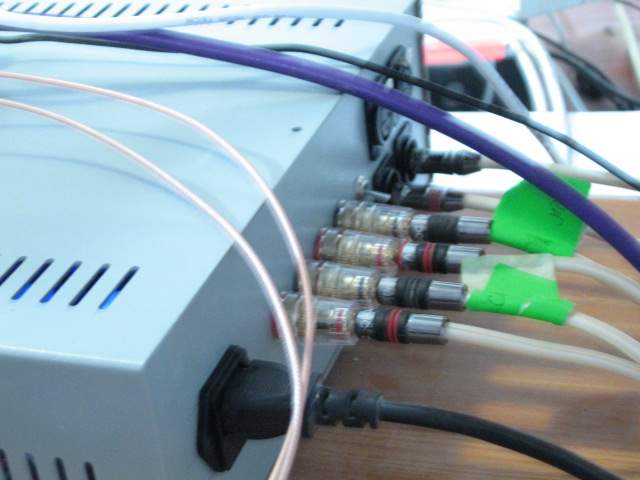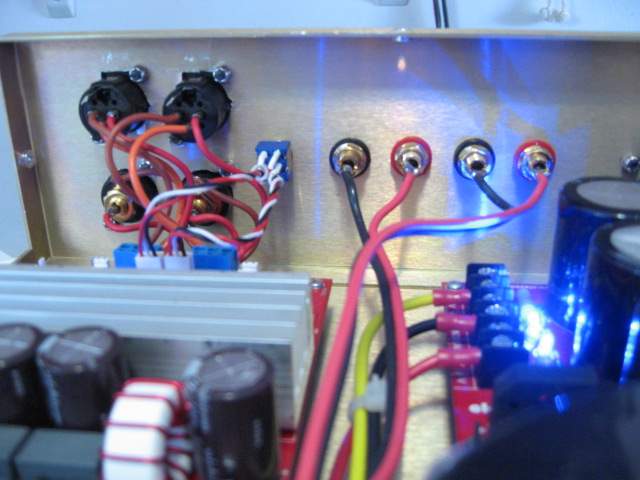Received my Built SDS-470 amp. One amp board with 250W X 2 into 8 and 2 X 500 into 4 ohms. Can bridge to 1 X 500. It's about 12 X 12 inches and 4 or so inches in height. Very heavy for it's size. That transformer is seriously big. Everyone who knows something about electricity and has seen the inside of the amp has commented on it.
The good news: It works, and looks pretty good, too. First impression of the sound is favourable. Will write more on that after it breaks in and I've had more of a chance to listen.
But getting there was a bit of a story.
Received the amp through International express mail. Got it home and opened the box. Disappointed....not packed well. Just placed in a cardboard box and then Styrofoam chips poured in to fill the box. That's it.
Plugged it in as a test and...fuse on my electrical board jumped. Tried a few different electrical chords and outlets- same result.
Opened the case: Wow, damage during shipment. Some of the screws attaching the amp board and PS board loosened from their sockets during shipment and the boards could move around inside the case. Also, two of the 3 cables connecting the transformer to the PS board had torn free. Apparently, rough handling together with the fact that the packing didn't prevent the whole amp from moving inside the box had generated forces that totally loosened several screws and cables.
Downloaded the electrical schematic from Tom's website, and wrote Tom to confirm that the way I thought to reconnect everything was correct. Left my phone number (I have a US VOIP number that forwards to my cell phone). Tom called later that day and confirmed my plan. Was very apologetic about the packaging, and promised to fix that issue. Also suggested I check the fuse and replace it.
Reconnected the loose bits. Turned amp on....the relevant house fuses still jumped. Luckily I have 2 neighbors who are electricians. One agreed to look so I brought him the amp. He came to the conclusion that two of the wires between the electrical (IEC) socket input and the on-off switch at the front were hooked up in reverse – one way on one end, the other way on the other end. He switched them to match the schematic. Turned on amp...no fuses jumped! Let's get this thing home and see what happens.
At home, placed the amp in system. Turned it on. But....no sound. Many expletives deleted.
At the suggestion of the electrician, wrote Tom and found out exactly what the voltage ins and outs at various points in the amp are supposed to be, so we could check for problems.
The second neighbor/electrician dropped by the next day. Asked him to get out his multi-tester and have a look. He did and immediately asked me if the amp had a burnt fuse. It hadn't previously, but now we checked and the fuse was most definitely burnt. Replaced fuse. Checked that amp seemed to be functioning according to values relayed by Tom. Yes... seems okay.
Plugged amp in, everything seemed fine, and all the little LEDs on the boards lighting up as they should.
Put amp back in system. Connected and turned everything on....no music/audio, just hum and noise....more expletives. Then remembered that the amp had a switch on the back for switching between “bridged” and “not bridged” modes. Flicked switch to other position and... music! No hum!
So in the end, the amp is working. But basically due to amateurish packaging, it arrived damaged and my experience with it was somewhat like doing it DIY. Not what should happen with a “finished” product. I'm just lucky I have friends who were willing to help me out.
As far as sound, I won't say too much till it breaks in and I listen some more. The amp is being fed from the pre-out of my MF-X-150 integrated (I will eventually replace the preamp also.)
First impressions: very noticeable increase in bass slam, and just a feeling of less strain, a more easy overall flow in the sound. Drums and bass definitely are improved. Soundstage is different, too. Just not sure how yet. This amp also seems "faster". So some very noticeable improvements, but I don't want to describe them as earthshaking. But this is only in the first few hours, we'll see what I think in a few days. I assume more differences will become apparent. Have to listen to some music that used to strain the system, like a big symphonic work, and see how that sounds.
Anyway, I think audiophiles often exaggerate the differences upgrades make. Every small difference becomes “a veil being lifted”, or “my system sounds totally different”, etc. I don't want to create expectations for others who might be thinking of buying one of these. But it does sound noticeably different, and is doing more or less what I hoped when I decided to by a class D amp with more than double the power of what I was using previously.
As far as cosmetics, it looks pretty good. The case looks more or less like a grey PC case, but the front panel is silver and in a brushed metal - quite nice. Doesn't look very different from the front panel of my MF equipment. How can you tell it's not a high end piece of equipment? The screws on the front panel are standard round Philips head screws. Not flat headed, and not flush with the surface of the front panel. As far as I know, this was the second “complete amp” Tom has sold, and the first silver one (the others are black). So the on-off switch and company logo are black. Don't blend well with the amp faceplate, IMO. I'm guessing Tom doesn't even have silver switches or logos to match the faceplate, at least for now. But hey, that's the kind of stuff you pay big bucks for when you buy from the "audiophile" companies. And this thing definitely didn't come with that kind of price tag.
Finally, I do want to stress that if it wasn't for the shipping problems, I'd have been very happy. The amp does seem to be well made, and with good parts. The binding posts are better than the ones on my MF amp, for instance. (I'll try to include some pictures).
Here's what I wrote Tom to sum up the buying experience:
“Suggestions for the future:
1) You have to pack future amps so they can’t move inside the box. Generally audio products I’ve received are packed with form fitting hard Styrofoam on 2 opposite sides of the device case that extend out to the sides of the box and prevent movement.
The other option would be to wrap it in bubble wrap so that with the wrap the amp totally fills the space in the box. That way it couldn’t move and would also be protected.
There are signs the amp also took a blow from below, so that has to be taken into account. You need some top/bottom protection . If I lived in the States, I simply would have asked you to replace/fix the amp upon receipt. It’s not a kit, so your customers for complete products aren’t going to want to fix them on their own – unlike kits. I was willing because the hassle and expense of shipping the amp back and forth to the States simply wasn't worth it.
2) I think you need to label all the connections and switches on the back. This is something that finished products have. For instance, the switch for the “bridge” isn't marked in any way, so I wouldn't have had any idea why there was a toggle switch on the back of the amp before I asked you.
3) Cosmetics. The brushed front panel looks quite nice. I know you’re just getting started making finished amps, but IMO the silver faceplate would look a lot classier if the on-off switch was silver colored, and the company logo was say, black or colored lettering on a silver background. Both would blend in much better with the silver faceplate that way and look more “high-end”.
Hopefully the amp will work fine for many years from here on out.”
